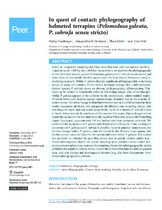In quest of contact: phylogeography of helmeted terrapins (Pelomedusa galeata, P. subrufa sensu stricto)

View/
Date
2018Author
Vamberger, Melita
Hofmeyr, Margaretha D.
Ihlow, Flora
Fritz, Uwe
Metadata
Show full item recordAbstract
Based on rangewide sampling and three mitochondrial and two nuclear markers
(together up to 1,850 bp and 1,840 bp, respectively), we examine the phylogeography
of two helmeted terrapin species (Pelomedusa galeata and P. subrufa sensu stricto) and
infer shifts of climatically suitable spaces since the Last Glacial Maximum using a
modeling approach. Whilst P. galeata displays significant phylogeographic structuring
across its range and consists of two deeply divergent lineages that could represent
distinct species, P. subrufa shows no obvious phylogeographic differentiation. This
seems to be related to historically stable or fluctuating ranges. One of the lineages
within P. galeata appears to be confined to the westernmost, winter-rainfall region
of South Africa and deserves special conservational attention due to the scarcity of
surface water. The other lineage is distributed further east and is differentiated in three
weakly supported subclades with parapatric distribution; one occurring inland, and
two along the south and east coasts, respectively. As far as is known, P. subrufa occurs
in South Africa only in the northeast of the country (Limpopo, Mpumalanga) and we
report the species for the first time from the Lapalala Wilderness Area in the Waterberg
region (Limpopo), approximately 350 km further west than previously recorded. We
confirmed the occurrence of P. galeata only 80 km south of Lapalala. Thus, a sympatric
occurrence of P. galeata and P. subrufa is possible. Another putative contact zone, for
the two lineages within P. galeata, must be located in the Western Cape region, and
further contact zones are likely for the eastern subclades within P. galeata. The nuclear
loci provided no evidence for gene flow across taxa or genetic clusters within taxa.
Future investigations should use denser sampling from putative contact zones and
more nuclear markers to re-examine this situation. Despite few phylogeographic studies
published for southern African biota, it seems likely that differentiation follows general
rules, and that climate and physiographic barriers (e.g., the Great Escarpment) have
shaped phylogeographic patterns.
